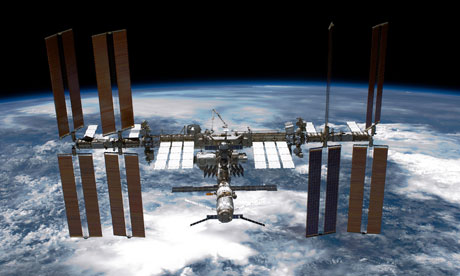Nasa and the European Space Agency have some ambitious plans. But if manned missions to Mars, super-thin spacesuits and shoebox-sized shuttles become a reality, then nanotechnology will undoubtedly have played a key role
 |
| Existing multi-tonne spacecraft may one day be swapped for shoebox-sized craft weighing just 2kg-5kg as developments in nanotechnology progress. Photograph: NASA/Getty Images North America |
Launching equipment into space is an expensive business: it costs $10,000 (£6,300) to lift every 0.45kg (1lb) of stuff into orbit. Making things smaller and lighter is, therefore, a natural route to reducing the cost of launching a spacecraft. It is no surprise then that the principles of nanotechnology – and the potential to reduce the mass and size of spacecraft and payloads – are focusing the minds of space engineers.
"When nanotechnology is really developed, even countries that don't presently think about space will be able to afford space exploration," says Meyya Mayyappan, chief scientist for exploration technology at Nasa's Centre for Nanotechnology, California.
He envisages swapping the multi-tonne spacecraft of today for shoebox-sized craft weighing just 2kg-5kg, yet matching all the capabilities of today's behemoths.
Taking its first step towards nano-sized instruments, Nasa has developed a sensor, which utilises nanotechnology, for the International Space Station (ISS) that is the size of a postage stamp and can detect toxins in the air. It was taken into space briefly in 2009 for tests and, according to Mayyappan, is now ready for deployment. It is likely to be incorporated into Nasa's space shuttle replacement vehicle and could be used on a future Mars rover to sample the alien atmosphere.
The sensor could also be modified to sample liquids. At present, astronauts' blood and urine samples have to be returned to ground control in Houston and checked in large-scale laboratories there for diseases, infections and general health. Nano-based sensors on board the ISS could provide instantaneous analyses and diagnoses. If manned Mars missions were ever to become a reality, such capabilities would be vital.
The European Space Agency (Esa) has also been studying the potential of nanotechnology. "There seems to be no limit to the potential application of nanotechnologies for space applications. Almost all technical domains covered by space research and development could benefit from these emerging technologies," says Laurent Marchand, head of components technology at Esa's European Space Research and Technology Centre, Noordwijk, the Netherlands.
Nanoengineering could produce surfaces that regulate spacecraft temperatures more efficiently than the materials used today. It could also generate more efficient solar cells, rendering large panels redundant. This summer, Esa will be hosting their eighth biannual meeting to assess the technological readiness of various micro and nano technologies. Topics of discussion will include the possible uses of nanotech, how to test its reliability in space, and the current strategy for the development of such systems for space.
While making smaller components is an obvious way to drive down the mass and power consumption of an otherwise conventional spacecraft, nanotechnology offers much more potential than that.
"Nanotech can completely change the way we do space exploration," says Constantinos Mavroidis, distinguished professor of engineering, Northeastern University, Boston, Massachusetts. In 2006, he assembled a team to investigate concepts that could be possible within 50 years. "We wanted to think of what was simply not possible without nanotech," he says.
They hit upon two ideas. The first was a lightweight spacesuit that was more flexible than current garments. It would consist of three layers and be suitable for spending long periods of time exploring the moon or Mars. Being thinner, however, the potential for damage would be higher, so Mavroidis investigated how to make it repair itself using self-assembling nanounits held inside the suit's layers. The nanounits would be based upon proteins and free to move along the suit layers. In the event of a breach, they would spill out, attaching to one another and building bridges across the damage. They could even carry emergency drugs to immediately treat any wound the astronaut may have suffered.
The team's second idea was a "spider's web" of hairline tubes that could be deployed across large tracts of a planet's surface. Inside the tubes would be an army of nanosensors that could measure the surface temperature and composition. Each web would span a dozen kilometres and be capable of sensing a planetary environment in great detail.
In space itself, nanotechnology-based missions hold great promise. Instead of general purpose spacecraft, hundreds or even thousands of identical microchip-sized spacecraft could be deployed to perform highly specific tasks. Using funding from the European Research Commission, Colin McInnes, professor of engineering, University of Strathclyde, Scotland, is currently studying such missions.
At present, Esa uses four nearly identical spacecraft called Cluster to measure the Earth's magnetic field and gauge its response to solar storms. Large numbers of smaller, nanotechnology-based spacecraft, known as "nanosats", could do a more detailed job by "carpeting" a much wider volume of space to provide continual monitoring of magnetic behaviour with high sensitivity.
Such nanosats would be so small that any gravitational attraction to the Earth would easily be overwhelmed by other forces, such as the pressure of sunlight and the minuscule drag of the Earth's highest atmosphere. This means that a nanosat would find it much easier to escape Earth's gravitational pull altogether, opening up new possibilities for propulsion.
Part of McInnes's study is to find the natural pathways in space that such nanosats could settle into. Once identified they could be exploited forfuture missions, allowing the tiny spacecraft to drift like dandelion fluff through the solar system.
"Nanotech is a new way of thinking about space missions. Once the idea is out there, people will think of all sorts of applications," says McInnes.
Fonte: The Guardian
